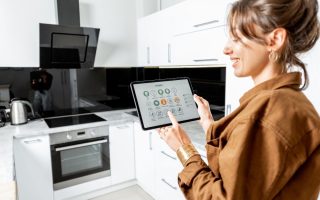Imagine walking into your home, and the lights automatically turn on, welcoming you with a warm, inviting glow. Or picture yourself relaxing in your living room as the lights dim softly for a cozy movie night. Smart lighting makes these scenarios possible, offering unparalleled convenience, energy efficiency, and customization. This article delves into the world of smart lighting, exploring its benefits, how it works, and why it’s a fantastic addition to any home.
What is Smart Lighting?
Smart lighting refers to advanced lighting systems that can be controlled remotely using a smartphone, tablet, or voice commands. These systems often include features like scheduling, automation, and integration with other smart home devices, allowing you to create the perfect ambiance and manage your lights effortlessly.
Customization and Personalization
One of the standout features of smart lighting is the ability to customize and personalize your lighting setup. Ian Evenden, Tech Journalist at TechHive, states, “Smart lighting isn’t just about convenience, it’s about personalization. You can customize the lighting in each room to suit your mood, activity, or time of day” (Source: TechHive).
Benefits of Smart Lighting
1. Convenience and Control
With smart lighting, you can control your lights from anywhere, whether you’re at home, at work, or on vacation. This means no more worrying about whether you left the lights on or coming home to a dark house. You can also adjust the brightness and color of your lights with a simple tap on your smartphone.
Ry Crist, Senior Editor at CNET Smart Home, emphasizes, “One of the coolest features of smart lighting is the ability to create custom scenes and schedules. You can set the mood for a romantic dinner, a relaxing bath, or a productive workday with just a few taps on your smartphone” (Source: CNET).
2. Energy Efficiency
Smart lighting systems can significantly reduce your energy consumption. They can automatically turn off lights when you leave a room or adjust the brightness based on natural light levels. This not only saves energy but also lowers your electricity bills.
Meg Graham, Smart Home Expert & Writer, points out, “Smart lighting can also help you save energy by automatically turning off lights when you leave a room or adjusting brightness based on natural light levels” (Source: Reviewed.com).
3. Integration with Other Smart Devices
Smart lighting can seamlessly integrate with other smart home devices, such as smart locks, thermostats, and security systems. For example, your lights can turn on automatically when you unlock your front door or dim when you start a movie.
Walt Zerbe, Senior Director of Technology & Standards at CEDIA, notes, “Smart lighting can integrate with other smart home devices to create a truly connected home experience. For example, your lights can turn on automatically when you unlock your front door, or dim when you start a movie” (Source: CEDIA).
4. Improved Sleep and Well-being
Smart lighting can also improve your sleep quality and overall well-being. By adjusting the color temperature and brightness of your lights throughout the day, smart lighting systems can help regulate your circadian rhythms and promote better sleep.
A study published in the Journal of Clinical Sleep Medicine (2022) examined the impact of smart lighting on sleep quality and circadian rhythms. The results indicate that smart lighting systems that adjust color temperature and brightness throughout the day can help regulate sleep-wake cycles and improve sleep quality.
How to Get Started with Smart Lighting
Step 1: Choose Your Smart Lighting System
There are several smart lighting systems available on the market, each with its own unique features and benefits. Some of the most popular options include:
- Philips Hue: Known for its wide range of bulbs, lamps, and accessories, Philips Hue offers extensive customization options and seamless integration with other smart home devices.
- LIFX: LIFX bulbs are known for their vibrant colors and brightness. They connect directly to Wi-Fi, eliminating the need for a hub.
- TP-Link Kasa: Affordable and easy to set up, TP-Link Kasa smart bulbs are a great option for those new to smart lighting.
Step 2: Install and Set Up Your Smart Lights
Once you’ve chosen your smart lighting system, follow the manufacturer’s instructions to install and set up your lights. This typically involves:
- Installing the smart bulbs or fixtures.
- Connecting the lights to your home Wi-Fi network.
- Downloading the corresponding app on your smartphone or tablet.
- Following the app’s instructions to complete the setup process.
Step 3: Customize Your Lighting
After setting up your smart lights, you can start customizing your lighting to suit your preferences. Use the app to create schedules, set scenes, and adjust the brightness and color of your lights. Experiment with different settings to find what works best for you.
Step 4: Integrate with Other Smart Home Devices
To fully unlock the potential of your smart lighting system, consider integrating it with other smart home devices. This can enhance your home’s automation and convenience. For example:
- Smart Locks: Set your lights to turn on automatically when you unlock your front door.
- Smart Thermostats: Sync your lighting with your thermostat to create a comfortable environment.
- Smart Speakers: Control your lights with voice commands using devices like Amazon Echo or Google Home.
My Personal Experience with Smart Lighting
Initial Setup
When I first decided to invest in smart lighting, I was a bit overwhelmed by the options available. After doing some research, I chose the Philips Hue system for its versatility and extensive features. The setup process was straightforward, and I had my new smart lights up and running in no time.
Customization and Convenience
One of the first things I did was set up custom scenes for different activities. I created a “Relax” scene with soft, warm lighting for evenings, a “Work” scene with bright, cool light for productivity, and a “Movie Night” scene with dimmed lights for a cozy atmosphere. These scenes made a significant difference in how I experienced each part of my day.
Energy Savings
Over the first few months, I noticed a decrease in my energy bills. The smart lighting system’s ability to turn off lights when not needed and adjust brightness based on natural light levels played a big role in this. It was satisfying to see the direct impact of this technology on my energy consumption.
Integration with Other Devices
As I expanded my smart home setup, I integrated my smart lights with other devices like my smart locks and thermostat. This integration added a new level of convenience. For instance, my lights now turn on automatically when I arrive home, and they adjust to optimal brightness based on the temperature settings of my thermostat.
Unique Insights
Start Small and Expand
One of the lessons I learned is to start small and gradually expand your smart lighting system. Begin with a few key areas in your home, such as the living room and bedroom, and slowly add more lights as you become more comfortable with the technology.
Focus on Usability
Choose smart lighting products that offer a user-friendly interface. This makes it easier to set up, adjust settings, and enjoy the benefits of smart lighting without frustration. Look for products with intuitive apps and clear instructions.
Regular Updates and Maintenance
Keep your smart lighting system up to date by regularly checking for firmware updates and performing any necessary maintenance. This ensures that your system continues to function smoothly and efficiently.
Experiment and Have Fun
Don’t be afraid to experiment with different settings and scenes to find what works best for you. Smart lighting offers endless possibilities for customization, so have fun exploring the options and creating a lighting setup that enhances your lifestyle.
Ready to transform your home with smart lighting? Start by researching different smart lighting systems and choosing one that fits your needs and budget. Remember to start small, focus on usability, and gradually expand your setup as you become more comfortable with the technology.
Investing in smart lighting is a step towards a more convenient, energy-efficient, and personalized home environment. With the ability to control your lights from anywhere, create custom scenes, and integrate with other smart devices, the possibilities are endless. Take the first step today and experience the benefits of smart lighting for yourself.




